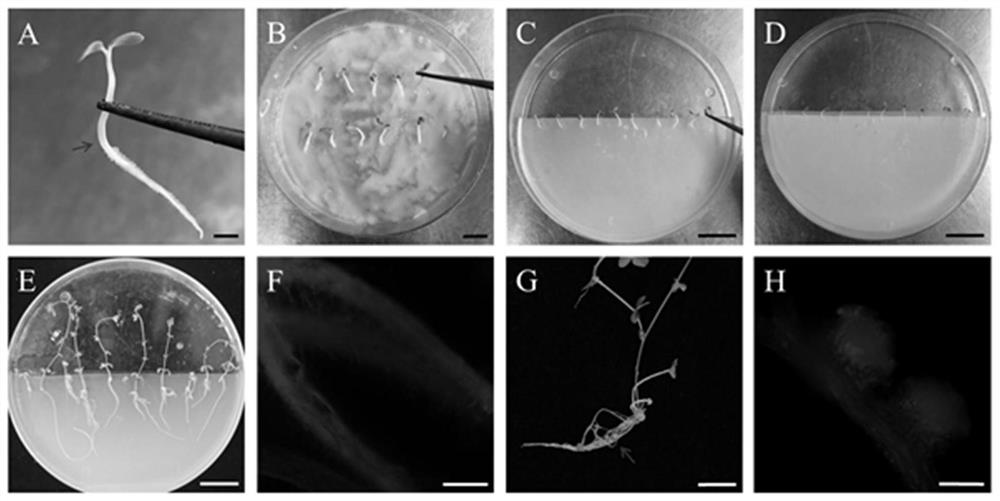Agrobacterium transformation vector based on rhizobium type III effector NopP and application of vector
An Agrobacterium transformation and effector technology, applied in the field of Agrobacterium transformation vectors based on Rhizobium type III effector NopP, can solve problems such as low transformation efficiency, achieve high transformation rate, overcome host-specific limitations, and study the symbiotic mechanism The effect of promotion
- Summary
- Abstract
- Description
- Claims
- Application Information
AI Technical Summary
Problems solved by technology
Method used
Image
Examples
Embodiment 1
[0023] The construction of embodiment 1 transformation vector
[0024] The vector pISV-DsRed1 T-DNA structure used in this experiment transformation is as follows: figure 1 As shown, the construction method of the vector adopts the standard enzyme-cut ligation method. All vectors contain the gene DsRed1 encoding red fluorescent protein in the mushroom coral Discosoma sp. as a selection marker for transgenic plants (Chen et al., 2009). First use PCR to amplify DsRed1 from pX-DR and connect it into the intermediate vector pRT104, cut it off with HindIII, put a 35S promoter on it, and then clone it into the pISV2678 vector to obtain pISV-DsRed1. Wherein, the bar gene expression cassette contained in the vector T-DNA region can use the herbicide Basta to select transgenic plants in other plant transformation experiments.
[0025] DsRed1 gene PCR reaction system:
[0026]
[0027]
[0028] Forward primer 1: GCTCTAGAACAATGGCCTCCTCCGAGAACGTC
[0029] Reverse primer 1: CCCTC...
Embodiment 2
[0043] Example 2 Transformation of Japonicus japonicus using Agrobacterium LBA1334, K599 and LBA1334 carrying pISV-DsRed1
[0044] The japonicus japonicus used in the experiment was (Regel) Larsen ecotype MG20 (Miyakojima MG20; Kawaguchi, 2000) seeds. The specific method includes the following steps.
[0045] 1. Surface disinfection and germination of seeds: Soak Japanese japonicus (Regel) Larsen ecotype MG20 (Miyakojima MG20; Kawaguchi, 2000) seeds with concentrated sulfuric acid for 10 min and then wash them with sterile water for at least 5 times. Then they were treated with 70% alcohol for 2 min and then transferred to 10-fold diluted commercial bleach (~0.35% active chlorine, Langkey, Guangzhou, China). Shake the seeds on a vortex mixer every 2 minutes for 10 minutes. Wash 5 times with sterile water, and finally resuspend the surface-sterilized seeds with sterile water and incubate overnight at 4°C. Then spread the seeds on 1.0% water agar plates (about 50 seeds per pl...
Embodiment 3
[0055] The vector pISV-DsRed1-nopP of the embodiment three nopP gene is transformed into LBA9402
[0056] Referring to the transformation method described in Example 2, the vector pISV-DsRed1-nopP containing the nopP gene was transformed into LBA9402, and finally used for hairy root transformation.
[0057] 1) Microscopic analysis was performed at 28dpi to detect red fluorescent roots. To detect the expression of effector genes, total RNA was extracted from roots showing red fluorescence. The transcription of nopP was detected by qRT-PCR, and the results were as follows Figure 5 As shown, it was confirmed that the effector genes could be co-expressed with DsRed1.
[0058] 2) Comparison of the transformation frequency between the control group treated with pISV-DsRed1 and the plants transformed with the binary vector containing the effector gene. Fifty plants were treated with each binary vector for testing. Among the plants of the LBA9402 treatment group carrying pISV-DsR...
PUM
 Login to View More
Login to View More Abstract
Description
Claims
Application Information
 Login to View More
Login to View More - R&D
- Intellectual Property
- Life Sciences
- Materials
- Tech Scout
- Unparalleled Data Quality
- Higher Quality Content
- 60% Fewer Hallucinations
Browse by: Latest US Patents, China's latest patents, Technical Efficacy Thesaurus, Application Domain, Technology Topic, Popular Technical Reports.
© 2025 PatSnap. All rights reserved.Legal|Privacy policy|Modern Slavery Act Transparency Statement|Sitemap|About US| Contact US: help@patsnap.com



